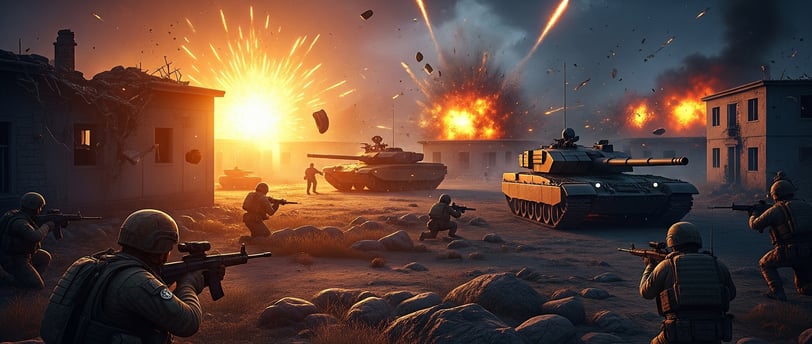Red Storm Rising Again: Is NATO Prepared for a Russian Blitz?
When Tom Clancy and Larry Bond co-authored Red Storm Rising in 1986, they painted a gripping vision of a conventional war between NATO and the Warsaw Pact that shook readers with its realism. Though fiction, it laid bare the doctrines, technologies, and strategic vulnerabilities that both sides would exploit in a high-intensity European conflict. Fast-forward to the 2020s, and the world finds itself peering into a chillingly familiar abyss. With Russia’s 2022 invasion of Ukraine reshaping Europe’s security calculus and NATO expanding its membership and posture, military scholars now ask a haunting question: What if Moscow launches a broader blitzkrieg-style assault westward? Is NATO truly prepared to respond swiftly, decisively, and cohesively?
DEFENCE INSIGHTSDEFENCE TECHDEFENCE READS
S Navin
5/25/20255 min read


The Modern Russian Military Machine: Capable but Bruised
Russian Military Structure and Capabilities Post-Ukraine
The war in Ukraine has exposed both the strengths and weaknesses of the Russian military. Despite initial operational blunders and logistical shortfalls, Russia has adapted—relying on mass mobilization, overwhelming artillery barrages, electronic warfare, and increasing integration of drones and precision strikes.
Key capabilities include:
Artillery Supremacy: Russia’s emphasis on massed fires remains deadly effective.
Integrated Air Defense: The S-400 Triumf and layered systems pose major challenges to NATO air dominance.
Hybrid Warfare Mastery: Information operations, cyberwarfare, and subversion through proxies remain core tools.
Nuclear Overhang: Russia’s strategic doctrine blurs lines between conventional and nuclear thresholds.
However, battlefield losses have revealed problems:
Corruption and logistical inefficiencies.
Rigid command structures and poor NCO corps.
Personnel attrition and declining morale.
Reconstitution Potential
Despite heavy losses, Russia retains vast reserves and the capacity to reconstitute forces. Defense spending has surged, and industrial capacity is being redirected for prolonged conflict. Moscow’s pivot to China, Iran, and North Korea for dual-use and military tech has plugged gaps, allowing the Kremlin to sustain pressure on Ukraine and possibly threaten other theaters.
NATO’s Military Posture: From Assurance to Deterrence
From Tripwire to Forward Defense
In the post-Cold War era, NATO adopted a "tripwire" posture—deploying small multinational battlegroups to reassure allies in the East. But after 2014 (Crimea) and 2022 (Ukraine), that posture has evolved:
Enhanced Forward Presence (eFP): Battalions in the Baltics and Poland are now better armed, better equipped, and integrated into national defense plans.
Rapid Deployment Forces: The NATO Response Force (NRF) and Very High Readiness Joint Task Force (VJTF) can deploy within days.
Prepositioning and Exercises: U.S. tanks in Poland, airlift drills, and annual DEFENDER-Europe exercises have expanded NATO’s responsiveness.
Yet, critics argue that NATO still lacks strategic depth, sufficient enablers (e.g., airlift, logistics, EW), and unity in operational tempo.
Interoperability and Command Unity
NATO’s strength lies in its 31-member consensus-driven model. But that is also a double-edged sword. Command structures must coordinate across multiple doctrines, languages, and national caveats. The Joint Force Command (JFC) in Brunssum and JFC Naples serve as strategic headquarters, but tactical unity in the face of a blitz could be stress-tested.
The Suwalki Gap: NATO’s Achilles’ Heel
Perhaps the most dangerous vulnerability is the Suwalki Gap, a narrow 65-kilometer corridor connecting Poland and the Baltic States. If Russia, leveraging forces from Kaliningrad and Belarus, seizes this corridor in a lightning strike, it could cut off the Baltics.
This is no longer hypothetical:
Russia's Zapad exercises simulate encirclement.
Belarus is increasingly militarized under Moscow’s thumb.
Kaliningrad is bristling with Iskanders and S-400s.
Holding the Suwalki Gap would require rapid multinational maneuver brigades, air parity, and coordinated fires. But current deployments may not suffice against a massed Russian assault.
Logistics and the “Speed of Assembly”
As General Ben Hodges aptly noted, "NATO doesn’t have a ‘military Schengen Zone.’" Cross-border military mobility is hampered by bureaucracy, differing rail gauges, and inadequate infrastructure.
A Russian blitzkrieg would exploit this by racing ahead of NATO’s political consensus and logistical deployment.
Efforts underway:
The Military Mobility initiative within the EU.
U.S. and German-led infrastructure audits.
Prepositioned stocks (APS) in Norway and Poland.
But much remains to be done. In a Red Storm Rising scenario, speed of assembly may matter more than absolute numbers.
Airpower and the Battle for the Skies
NATO enjoys overwhelming air superiority in terms of numbers, training, and platforms—F-35s, Eurofighters, tankers, and AWACS.
But Russia’s integrated air defense network and EW capabilities (Murmansk-BN, Krasukha) could deny access and delay air operations long enough for Russian ground forces to gain key terrain.
Questions remain:
Are NATO’s SEAD/DEAD capabilities sufficient?
Can stealth and cyber disable Russian IADS early enough?
Is the alliance prepared for attritional air combat, not just precision strikes?
Cyber and Hybrid Warfare: The New First Strike
Before tanks roll, cables are cut, satellites are jammed, and Twitter trends are hijacked.
Russian doctrine (Gerasimov) treats non-kinetic, hybrid, and psychological operations as precursors to kinetic action. A Red Storm redux would begin with:
Cyberattacks on critical infrastructure.
Disinformation campaigns to delay NATO consensus.
Proxy destabilization in vulnerable nations (e.g., Balkans, Moldova).
NATO’s Cyber Command (established 2018) is growing, but offensive capabilities remain nationally retained, and Article 5 triggers for cyberattacks are still ambiguous.
Nuclear Shadows and Strategic Calculations
Russia’s doctrine allows for “escalate to de-escalate”—the use of tactical nuclear weapons to forestall NATO intervention. Coupled with Iskanders in Kaliningrad and nuclear-capable bombers in Murmansk, this raises terrifying prospects:
Would NATO respond to a tactical nuclear strike with conventional force?
Could the alliance maintain cohesion under existential pressure?
NATO’s own deterrent triad (U.S. nukes in Europe, British-French capabilities) remains credible, but the political will to cross the nuclear threshold remains deeply uncertain.
Political Unity: The Real Center of Gravity
Military power means little without political cohesion. The 2022 invasion of Ukraine galvanized NATO like never before—but how enduring is that unity?
Challenges include:
Diverging threat perceptions (e.g., Mediterranean vs Eastern Flank).
Populist politics and anti-war sentiments.
Burden-sharing fatigue: only a few members consistently meet the 2% GDP defense spending goal.
In a Russian blitz, the first target would be NATO’s decision-making process, slowing consensus through cyber-disruption and strategic ambiguity.
Lessons from Ukraine: Proxy Previews of the Big War
Ukraine has been a testing ground for both Russian and NATO doctrines.
What NATO learned:
Precision weapons (HIMARS, Javelins) are force multipliers.
ISR and real-time intelligence sharing (via drones, satellites) are decisive.
Civil resistance and morale matter.
What Russia learned:
Logistics must be hardened and decentralized.
Drones and electronic warfare are decisive.
Protracted wars require industrial resilience, not just elite units.
These insights will shape both sides’ approach in any future confrontation.
Strategic Scenarios: What Could a Blitz Look Like?
Scenario A: Kaliningrad Gambit
A sudden mobilization from Kaliningrad and Belarus cuts the Suwalki Gap, isolates the Baltics, and presents a fait accompli. NATO is forced into a costly liberation campaign or faces permanent division.
Scenario B: Baltic Shock and Awe
Simultaneous amphibious and airborne assaults on Estonia and Latvia overwhelm local forces before NATO can deploy. Hybrid uprisings confuse response timelines.
Scenario C: Distraction in the South
Russia stirs instability in the Balkans or Black Sea, diverting NATO’s focus before striking Poland or Lithuania in a "secondary" axis of advance.
In each case, NATO’s ability to deploy, sustain, and politically unite within 48–72 hours is the key determinant of success.
Conclusion: Is NATO Ready?
In many respects, NATO is stronger than ever—with improved posture, expanded membership (Finland and Sweden), and renewed political will.
Yet, readiness for a rapid, multifront Russian blitz is far from assured. Key gaps persist:
Slow strategic mobility.
Limited tactical air and missile defense.
Fragile political consensus under pressure.
Undefined cyber and nuclear red lines.
Red Storm Rising may have been fiction, but its core premise remains chillingly real: a determined adversary exploiting delays in consensus and movement can change the map before the world can act.
